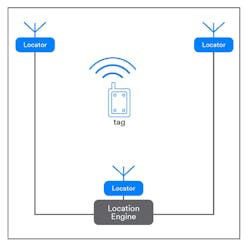The Global Positioning System (GPS) has been a boon for transportation, but it only works if the receivers can communicate with multiple GPS satellites. Though that’s not too difficult outdoors, it’s typically impossible or inaccurate indoors. Other solutions are normally needed to provide location services indoors. Proprietary solutions have been available and standard platforms like Bluetooth deliver basic location support.
Bluetooth stands out because of its ubiquitous nature. The challenge has been implementation of location services in a standard fashion. To date, Bluetooth has supplied useful but low-accuracy positioning information (Fig. 1). The Bluetooth Low Energy (BLE) standard allowed two Bluetooth devices to get the approximate distance between the two devices utilizing received signal-strength measurements. This provides good proximity information and is effective when detailed position information isn’t required.
1. Bluetooth has supported proximity and positioning systems that provide basic distance and positioning via triangulation.
For example, a beacon that’s providing advertising only needs to know if a device is within a specified range to deliver useful information. This point-of-interest approach has many applications, such as conveying multimedia feedback in a museum about a particular exhibit.
Applications like asset tracking in a warehouse requires more complex location support since relative position is also needed. Likewise, more accurate range results can be useful. Bluetooth supports real-time locating systems (RTLS) as well as indoor positioning systems (IPS). This requires multiple Bluetooth sensing systems to determine the position of a device using trilateration (Fig. 2). As of now, the accuracy of this system is rather course, ranging from one to ten meters of accuracy. It’s usually sufficient for systems like robots that need to navigate with a building or warehouse.
2. Multiple devices are used to implement a Bluetooth indoor positioning system (IPS).
The latest Bluetooth standard (5.1) allows systems to employ antenna arrays to determine the direction of communication (Fig. 3). A single device with such an array can be used with any other Bluetooth device to determine the relative direction to each other. This is done by measuring the angle of arrival (AoA) or angle of departure (AoD) depending on the direction of communication and which device has the antenna array.
3. Bluetooth 5.1 can determine the angle of transmission to provide relative positioning from a pair of devices.
A device without an array can obtain the information from the other device. Orientation of each device is also possible when both devices have the more advanced antenna support. New Bluetooth profiles are being developed to include this location feature, which can provide positioning down to the centimeter level.
The standard is just out the door, but we can expect to see it in devices like smartphones that will be able to determine the location of existing Bluetooth devices more accurately. Likewise, Bluetooth devices specifically geared for location support will be common in buildings and on robots and drones. Bluetooth 5.1 stacks with matching antenna support will be available from most Bluetooth hardware vendors. As a result, incorporating this feature in a system should be no more difficult than including earlier Bluetooth support.



